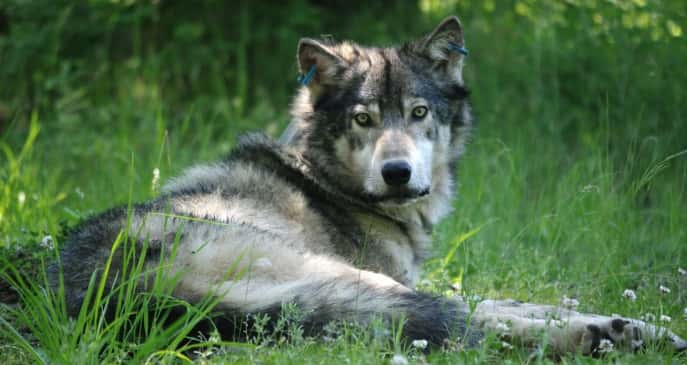State wildlife biologists counted 173 wolves in Oregon this past winter, a 9.5 percent increase over last year’s count of 158 according to the Oregon Wolf Conservation and Management 2020 Annual Report released today at odfw.com/wolves. This annual count is based on verified wolf evidence (like visual observations, tracks, and remote camera photographs) and is considered the minimum known wolf count, not an estimate of how many wolves are in Oregon. The actual number of wolves in Oregon is likely higher, as not all individuals present in the state are located during the winter count.
A total of 22 packs were documented during the count. (A pack is defined as four or more wolves traveling together in winter.) Of those packs, 17 reproduced and had at least two adults and two pups that survived through the end of 2020, making them “breeding pairs.” Seven other groups of 2-3 wolves were also identified. While no new packs formed in western Oregon, the total number of wolves in the region increased by 29 percent (from 17 to 22 wolves) over the 2019 count. Eight collared wolves dispersed from their packs with four dispersing to other locations in Oregon, two to Idaho, one to California, and one wolf left California and became resident in Oregon.
“While northeast Oregon continues to host majority of state’s wolf population, dispersal to other parts of Oregon and adjacent states continues,” said Roblyn Brown, ODFW Wolf Coordinator.
A total of 21 wolves were captured and radio-collared during 2020, up from 14 last year. Four of those were thanks to licensed trappers promptly reporting their incidental capture of a wolf; ODFW was able to radio collar and safely release those four wolves from foothold traps. Through collar data and surveys, the Department collected 17,279 wolf location data points in Oregon in 2020. Of those, 57 percent of locations for resident wolves were on public lands, 38 percent on private lands, and 5 percent on tribal lands.
Wolf mortalities
Nine wolf mortalities were documented during 2020, including two young wolves that died from natural causes (a Wenaha pup and Indigo yearling). Seven wolf mortalities were human caused. One wolf was killed when hit by a vehicle on I-84, another was apparently killed when hit by a boat while swimming across the Snake River.
One was taken lawfully under the “caught in the act” rule which allows livestock producers to shoot a wolf found in the act of biting, wounding, killing or chasing livestock. (As of January 4, 2021 “caught in the act” is legal statewide but rules differ for East and West Zones which are in different phases of wolf management; livestock producers should visit ODFW’s webpage to find out more.)
Four wolves were killed illegally in 2020. Three deaths are still under investigation, and OSP is actively seeking more information. The breeding male of the Ruckel Ridge Pack was shot in Umatilla County in May. The breeding male of the Cornucopia Pack was shot in September in Baker County. A subadult wolf, believed to be from the Pine Creek Pack, was shot in October in Baker County.
Rewards ranging from $2,500 to $15,000 have been offered for information leading to a conviction. Public reports help protect Oregon wildlife from poaching. Reports can be made anonymously to the OSP Turn In Poachers (TIP) Line at 800-452-7888 or by email: TIP@osp.oregon.gov.
Finally, a livestock owner shot a wolf mistaken for a coyote. The owner was warned by Oregon State Police after self-reporting the incident to OSP.
“Hunters and livestock producers in areas of wolf activity really need to be careful and be able to tell the difference between wolves and coyotes,” said Brown. Review ODFW’s Coyote vs Wolf ID quiz for tips.
ODFW did not lethally control any wolves in response to chronic depredation in 2020.
Livestock depredation increases, mostly attributed to Rogue Pack
Confirmed depredation events increased 94 percent in 2020 from 2019. The majority of the depredation (52 percent) was attributed to the Rogue Pack, which depredated 16 times in 2020.
In all phases of wolf management, Oregon’s Wolf Plan mandates that non-lethal efforts are undertaken to address conflict before lethal removal is considered. In 2020, those measures included removing attractants, hazing, electrified fladry, radio-activated guard boxes, increased human presence, range riders and other husbandry practices.
In the Rogue Pack area, ODFW and partners U.S. Fish and Wildlife Service and USDA Wildlife Services worked extensively to try to limit depredation, including a coordinated nighttime patrol in Klamath County to haze wolves out of livestock pastures in the northern Wood River Valley where depredation was concentrated. Agency staff hazed all night on 99 nights between July 30-Nov. 25. This overnight agency presence leveraged real time information about wolf locations derived from howling, radio-telemetry, cattle disturbance, and visual observation through night-vision thermal imaging devices in an attempt to deter wolves. The hazing pushed the wolves back into the forest on some nights, but other nights they depredated.
“The personnel costs of this collaboration with USFWS, WS and the Department was significant during the four months,” said Brown. “We appreciate the work of our partners and all livestock producers for their efforts to co-exist with wolves.”
Counties can seek grants from Oregon Department of Agriculture’s (ODA) Wolf Depredation Compensation and Financial Assistance Grant Program to help fund non-lethal measures and compensation for lost livestock. In 2020, ODA awarded $251,529 to 12 counties, up from $178,319 awarded in 2019.
ODFW staff will present an overview of the Oregon Wolf Conservation and Management 2020 Annual Report to the Fish and Wildlife Commission at their April 23 meeting. No public testimony is being taken during that portion of the meeting but it can be watched online and public comments can be sent to odfw.commission@state.or.us







